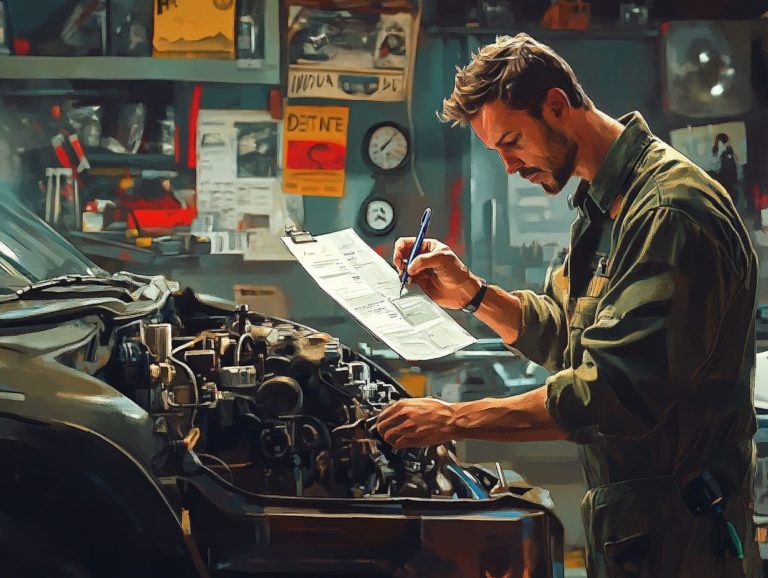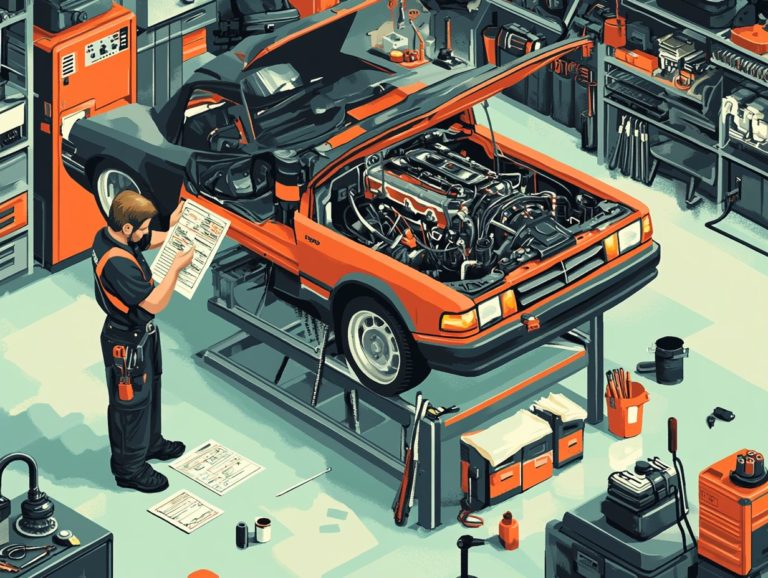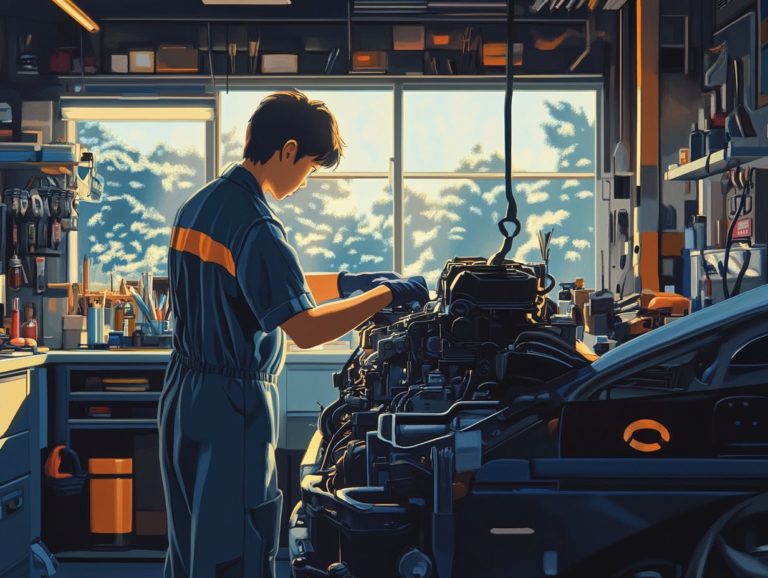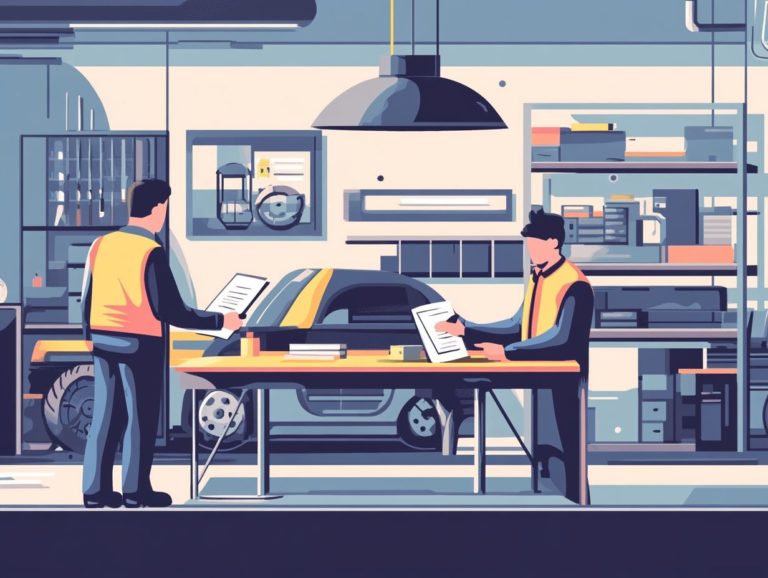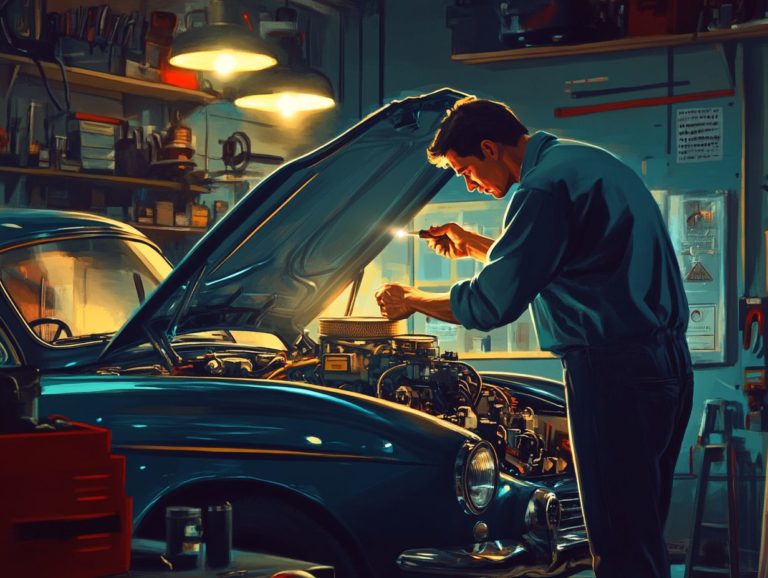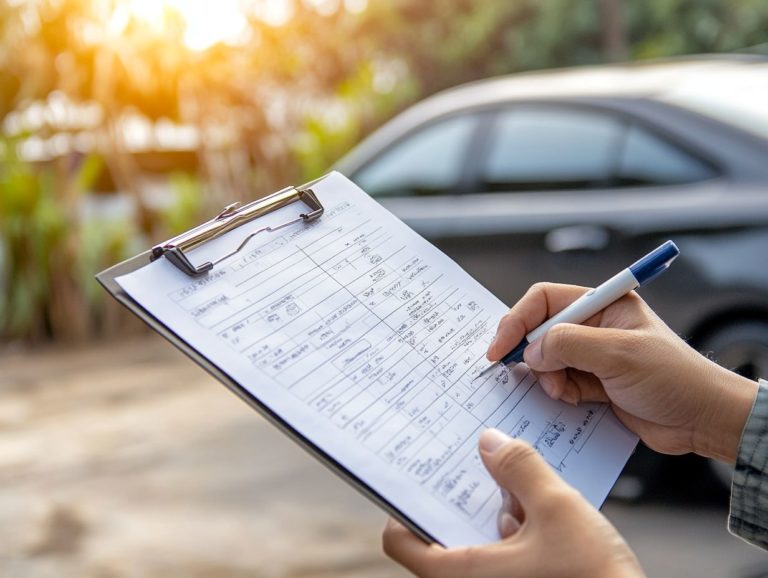Essential Car Inspection Checklist Before Buying a Used Car
Purchasing a used car can evoke a mix of excitement and apprehension. Make the smart choice follow this checklist to ensure your next car is a great one!
This article presents a comprehensive checklist to navigate the fundamental steps of inspecting a used car. From scrutinizing the exterior and interior to checking for leaks and testing the engine, each aspect is crucial.
This article also highlights the advantages of a thorough inspection and points out important red flags to be vigilant about. Arm yourself with the insights needed to make an informed decision and drive away with confidence!
Contents
- Key Takeaways:
- 1. Check the Exterior of the Car
- 2. Inspect the Interior of the Car
- 3. Check for Any Leaks or Rust
- 4. Test Drive the Car
- 5. Check the Tires and Suspension
- 6. Look for Any Signs of Accident Damage
- 7. Check the Engine and Under the Hood
- 8. Inspect the Electrical System
- 9. Check the Fluid Levels
- 10. Verify the Vehicle History Report
- 11. Look for Any Warning Lights
- 12. Test the Brakes and Steering
- 13. Check the Exhaust System
- 14. Inspect the Safety Features
- 15. Consider Getting a Professional Inspection
- What Are the Benefits of Getting a Used Car Inspected?
- Frequently Asked Questions
- Ready to buy a used car? Check out this essential inspection checklist!
- Why is it important to have an essential car inspection checklist before buying a used car?
- What are the key components that should be included in an essential car inspection checklist?
- Can I do the car inspection myself or should I hire a professional?
- What if the used car I want to buy does not pass the essential car inspection checklist?
- Is it possible to find a used car that passes the essential car inspection checklist with flying colors?
Key Takeaways:
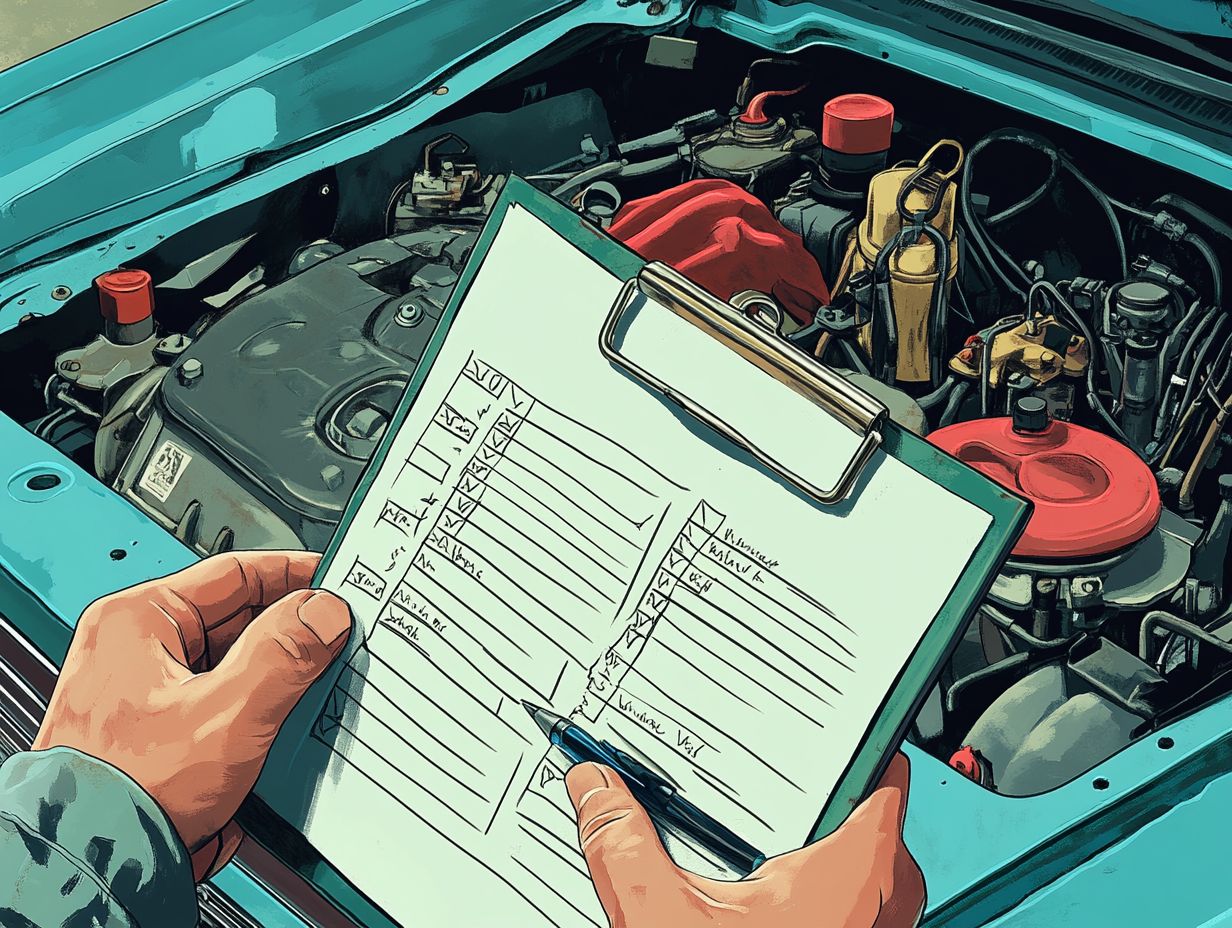
- Before buying a used car, carefully inspect the exterior, interior, engine, and safety features to avoid any potential issues.
- Test drive the car to ensure it runs smoothly.
- Check for any signs of leaks, rust, or accident damage.
- Consider getting a professional inspection and verifying the vehicle history report, which is a document that shows the car’s past incidents and ownership, to have a clear picture of the car’s condition before making a purchase.
1. Check the Exterior of the Car
When you choose to purchase a used car, one of the most crucial steps is to carefully inspect the vehicle’s exterior. This ensures it meets your standards and safety requirements while reflecting the dealer’s commitment to offering quality pre-owned vehicles. To make the process smoother, consider following this guide on preparing for a used car purchase.
Start by examining the paint condition; look for any inconsistencies or scratches that may hint at prior accidents. Be vigilant for signs of rust, particularly around the wheel wells and undercarriage, as these can point to more serious underlying issues.
The alignment of body panels is revealing; uneven gaps may indicate past damage. Don t overlook the functionality of safety equipment ensure that headlights and mirrors are both intact and operational.
A brief check of features like signals and brake lights will complete your assessment. Ultimately, a well-maintained exterior can serve as a strong indicator of the overall condition and care the vehicle has received.
2. Inspect the Interior of the Car
A thorough interior review of a used car is essential for you. It reveals the comfort, available features, and provides insight into the car’s maintenance history and overall condition, which can significantly impact your long-term satisfaction.
When you examine the interior, take a close look at the quality of the upholstery. Scanning for tears, stains, or signs of fading can tell you a lot about how well the previous owner cared for the vehicle.
Don t forget to test the functionality of interior features like air conditioning and Bluetooth connectivity to ensure they operate smoothly. Checking for scratches, worn buttons, and the condition of the floor mats can provide further clues about the car’s usage.
Reviewing service records is crucial; they offer valuable insights into past repairs and maintenance performed. This information will help you make a well-informed decision about your investment.
3. Check for Any Leaks or Rust
Checking for leaks and rust is essential when evaluating a used car, and using an inspection checklist for vintage cars can help identify these issues, as they can significantly impact both maintenance costs and the vehicle’s overall longevity.
As a potential buyer, you should carefully inspect underneath the car for any puddles of fluid, which might signal leaks from the engine, transmission, or coolant system.
It s equally important to focus on areas prone to rust, such as the wheel wells and undercarriage, where moisture tends to gather.
Identifying these problems early not only helps you avoid expensive repairs later on. Highlighting these concerns could also allow you to negotiate a lower purchase price, making your investment that much wiser.
Don t skip the inspection your future rides depend on it!
4. Test Drive the Car
A test drive is an essential step in the used car buying journey, providing you with a direct experience of how the car performs. It s also your opportunity to assess its mileage and maintenance history.
During this critical moment, it s wise to pay close attention to several key factors. For example, you should observe how the engine responds when you accelerate and listen for any unusual sounds when braking.
The comfort level while driving, especially on various road surfaces, can offer valuable insight into the vehicle’s true condition.
Having these notes at hand not only strengthens your bargaining position but also showcases a level of diligence that sellers respect. This meticulous approach enables you to make a more informed decision, ensuring you drive away with the best possible deal.
5. Check the Tires and Suspension
Evaluar la condici n de los neum ticos y la suspensi n de un autom vil usado es absolutamente vital, ya que estos componentes juegan un papel crucial en tu seguridad y comodidad al conducir.
Comienza con una inspecci n visual exhaustiva de los neum ticos; esto revela informaci n clave sobre los patrones de desgaste. Busca desgaste irregular o excesivo de la banda de rodadura, ya que esto puede indicar problemas de c mo est n alineadas las ruedas.
No olvides medir la profundidad de la banda de rodadura para asegurarte de que cumple con los est ndares de seguridad. Bandas de rodadura m s profundas te proporcionar n mejor agarre, especialmente en condiciones h medas.
Durante tu prueba de manejo, presta mucha atenci n a c mo responde la suspensi n. Cualquier rebote o ruido excesivo podr a se alar problemas subyacentes que podr an llevar a reparaciones costosas en el futuro.
Al evaluar estos factores esenciales, estar s bien preparado para tomar decisiones informadas, lo que, en ltima instancia, aumentar tu confianza en la fiabilidad y el rendimiento del autom vil usado.
6. Look for Any Signs of Accident Damage
Spotting signs of accident damage is crucial when considering a used car. Past incidents can significantly affect both its current shape and future resale value.
When you inspect the vehicle, take a moment to carefully examine the body panels for any irregularities that might indicate previous repairs. Pay attention to uneven gaps between components; misaligned parts could suggest that the car has undergone substantial structural work.
Look for signs of repainting, like variations in color or texture across the panels, as these can reveal hidden damage. To protect yourself from purchasing a car with a questionable history, obtaining a vehicle history report is essential.
This report will shed light on the car’s accident history, enabling you to make an informed decision while also underscoring the dealer’s commitment to transparency in their transactions.
7. Check the Engine and Under the Hood
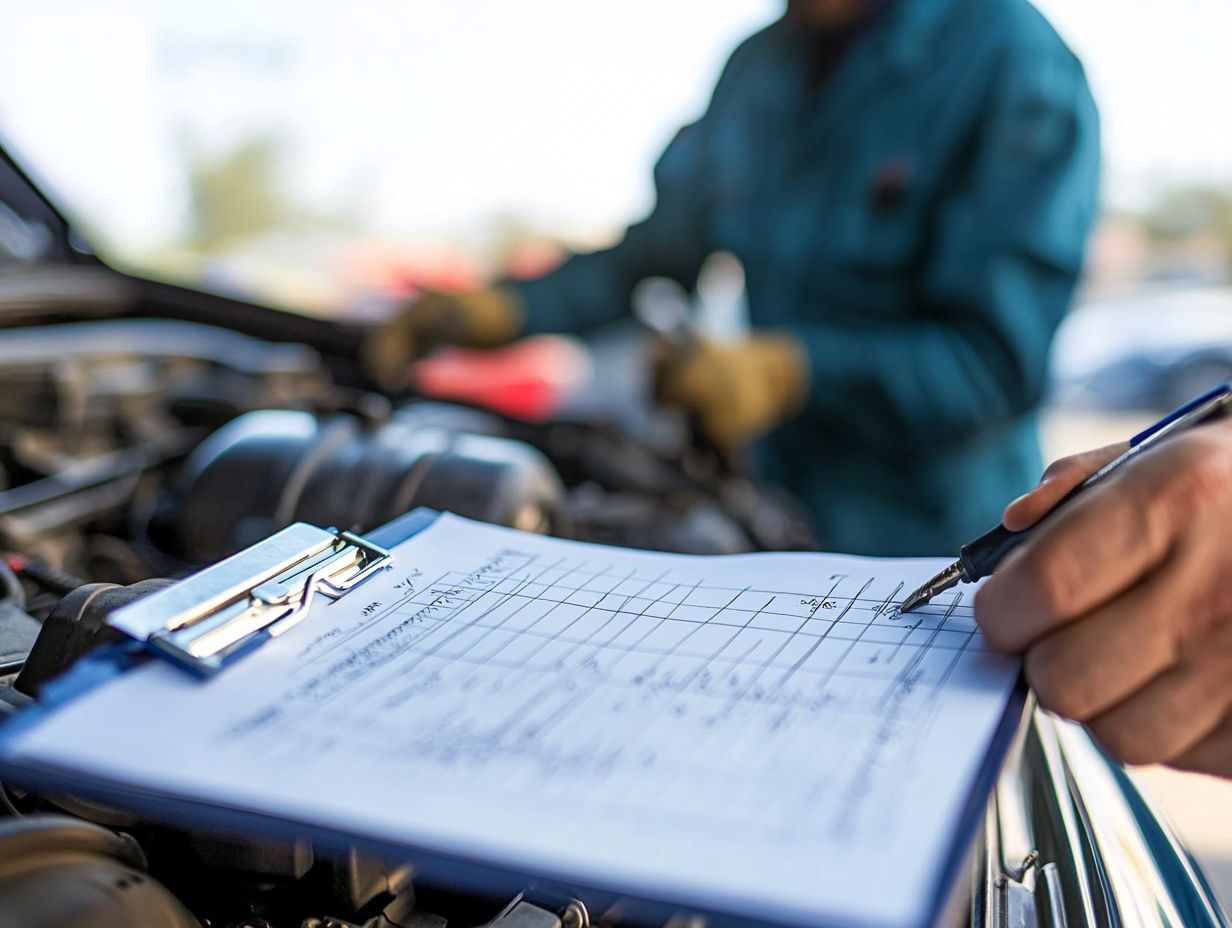
A thorough engine inspection and assessment of the under-the-hood components are essential when you’re contemplating the purchase of a used car. To ensure you cover all necessary aspects, learn how to use a car inspection checklist effectively. This process can reveal not only the vehicle’s maintenance history but also potential repair needs that may lie ahead.
Checking fluid levels is crucial, including the engine oil and transmission fluid, to ensure the vehicle operates smoothly. Begin by locating the dipstick for the engine oil; wipe it clean, then reinsert it to assess the oil’s level and quality.
For the transmission fluid, you might need a different approach, as it often requires the car to be level and running for an accurate reading.
As you start the engine, pay close attention to any irregular sounds that could signal underlying issues. A quick glance at the cleanliness of the engine compartment can reveal a lot about how well the vehicle has been maintained throughout its life.
8. Inspect the Electrical System
Is your used car ready to hit the road? Start by checking its electrical system! Inspecting the electrical system is crucial. It ensures that every feature, from the headlights to the infotainment systems, operates smoothly and can impact your warranty options.
To attain a comprehensive assessment, methodically check various components, including interior lights, the functionality of the radio, and the responsiveness of power windows.
By thoroughly evaluating these elements, you not only gauge the overall condition of the vehicle but also pinpoint areas that may need future repairs. It’s essential to ask about any available warranty options. This inquiry provides peace of mind against unexpected electrical failures, making your investment in a used car feel much more secure.
9. Check the Fluid Levels
Checking the fluid levels in a used car such as oil, brake fluid, and coolant is an essential step in ensuring the vehicle’s operational health and reflecting its maintenance history.
By regularly monitoring these fluid levels, you maintain optimal performance and prevent potential issues that could arise from neglect. For example, low oil levels can lead to significant engine wear, while insufficient brake fluid can compromise braking efficiency, creating safety risks.
Neglecting these crucial checks may result in costly repairs down the line, impacting your immediate maintenance expenses and the long-term resale value of the vehicle. A well-maintained car with proper fluid levels attracts better offers when it s time to sell, making your diligence pay off.
Check your fluid levels today to keep your car in top shape!
10. Verify the Vehicle History Report
Verifying the vehicle history report is essential in your used car buying journey. It offers valuable insights into the ownership history, past accidents, and any significant repairs that may have taken place.
This report reveals odometer readings, helping you spot inconsistencies that could indicate tampering. Pay close attention to the service records; they reflect how well the vehicle has been maintained over the years.
A well-documented maintenance history often means fewer future repair costs. Check for any safety recalls that might not have been addressed, giving you peace of mind while you re on the road.
Gather this information now to make the best decision and save yourself from future headaches!
11. Look for Any Warning Lights
Paying close attention to the warning lights on the dashboard is essential when inspecting a used car. These lights can signal underlying issues that may compromise the vehicle’s condition and safety.
Think of these lights as vital indicators, alerting you to everything from low oil pressure and battery troubles to specific engine malfunctions. During your test drive, keep a close eye on the dashboard; any warning that lights up could reveal concerns that deserve further investigation.
Having a solid understanding of what each warning light means enables you to make informed decisions. Considering a comprehensive inspection guide can offer valuable insights into the significance of each warning and the necessary steps to address them, ensuring you re making a sound investment for the future.
12. Test the Brakes and Steering
Check the brakes carefully and test the steering of a used car for your safety and performance. These components are critical for effective handling and control.
- Start by ensuring that the brakes respond promptly when you press down any noticeable delay could signal a problem lurking beneath the surface.
- While cruising at a safe speed, gently apply the brakes to gauge their responsiveness and reliability.
- Keep your ears tuned for any unusual sounds, like squeaks or grinding; these can reveal hidden issues that might not be immediately obvious.
Equally important is the steering; it should feel firm and precise, without any vagueness or excessive play. This directly impacts your ability to maneuver effectively. Additionally, functioning safety features like anti-lock brakes and traction control are vital for bolstering the overall reliability of these systems.
Your attention to these details can make all the difference.
13. Check the Exhaust System
Checking the exhaust system of a used car is crucial. It can unveil vital insights into the vehicle s overall condition and anticipated maintenance costs, making it an essential part of your inspection process.
As you inspect, be vigilant for signs of rust or leaks. These red flags can signify underlying issues that might lead to diminished performance and increased emissions.
A well-functioning exhaust system is key to optimizing engine output and ensuring compliance with environmental standards. Regular checks maintain efficiency and help you avoid expensive repairs down the road.
For long-term ownership, prioritizing the health of this system enhances both the vehicle s longevity and your peace of mind. This creates a more enjoyable and seamless driving experience.
14. Inspect the Safety Features
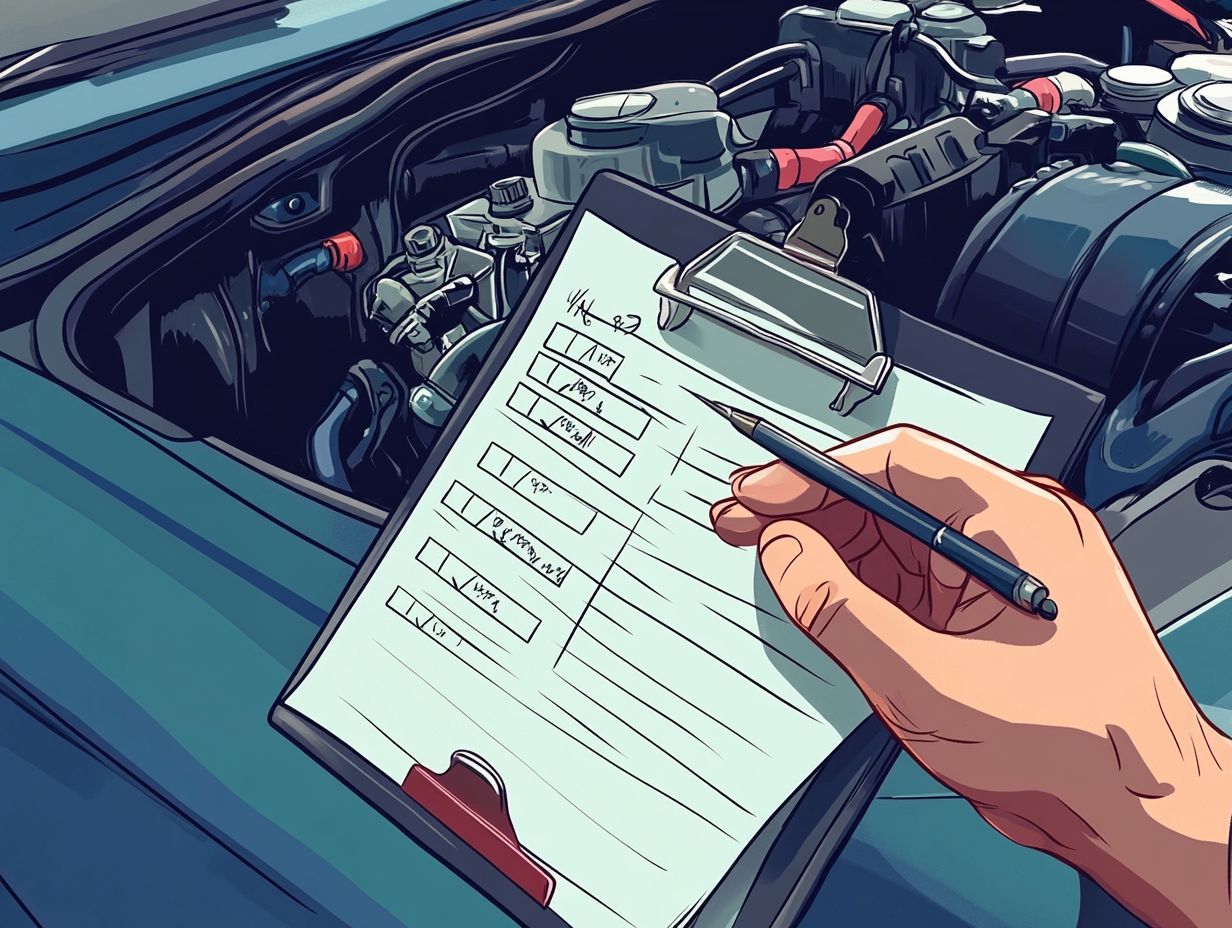
Inspect the safety features of a used car, as these are essential for your protection on the road. For more detailed guidance, check out how to assess used car condition.
These features play a significant role in the car’s safety ratings and compliance with safety recalls.
When evaluating a vehicle, prioritize checking for the presence and functionality of:
- Airbags, designed to cushion you and your passengers during a collision.
- Brakes that prevent the wheels from locking up during sudden stops, crucial for maintaining steering control in emergencies.
- The traction control system, which helps prevent wheel spin and enhances grip on slippery surfaces.
Lastly, review the vehicle’s history for any past safety recalls related to these components. Ensuring these issues have been addressed will provide peace of mind and significant protection for you and your passengers.
15. Consider Getting a Professional Inspection
Don t skip a professional inspection before you buy. It can save you from major headaches.
A certified mechanic brings a wealth of expertise to assess the vehicle’s critical components. They’ll evaluate engine performance, transmission condition, brake functionality, and suspension integrity.
By identifying potential issues early, you gain a significant advantage during price negotiations. Pointing out necessary repairs might give you leverage for a better deal.
This approach leads to a more financially sound investment and enhances your peace of mind. It ensures the vehicle will provide reliability and longevity on the road while safeguarding you against unforeseen expenses.
What Are the Benefits of Getting a Used Car Inspected?
Getting a used car inspected offers you a wealth of benefits, including peace of mind about the vehicle’s condition, potential savings on maintenance costs, and the assurance that you are making a wise investment. For detailed information, refer to the ultimate pre-purchase car inspection guide, which includes essential components of a comprehensive buyer’s guide.
A thorough inspection uncovers hidden issues that may not be apparent during a casual look-over. This ensures you won t be stuck with unexpected repair bills later.
It s crucial for confirming that the vehicle meets safety compliance standards, protecting the well-being of everyone inside. An inspection can also boost the car’s resale value, making it a smart financial move.
For anyone considering a used vehicle purchase, weighing these benefits enables you to make a more informed and confident decision.
What Are the Red Flags to Look Out for When Inspecting a Used Car?
When inspecting a used car, keep an eye out for several red flags. These include inconsistencies in the vehicle history, signs of previous accidents, and unusual odors that may hint at underlying issues.
If you notice mismatched paint on different parts of the vehicle, it could indicate a rushed or incomplete repair job. Excessive rust is another warning sign, pointing to neglect or prolonged exposure to moisture.
Pay attention to any dashboard warning lights that remain illuminated. They could suggest undisclosed mechanical problems that are best addressed before making a purchase.
Trust your instincts during the inspection process. If something feels off, it s worth your time to do thorough due diligence.
This could mean obtaining a vehicle history report or getting the car inspected by a trusted mechanic.
How Can a Car Inspection Help with Negotiating the Price?
A thorough car inspection can significantly aid you during negotiations by providing concrete evidence of the vehicle’s condition, including any maintenance history that may justify a lower purchase price.
When you review a detailed inspection report, you can pinpoint specific issues such as engine wear, tire quality, or brake performance that warrant further discussion with the seller. Highlighting discrepancies in the vehicle’s upkeep or noting safety concerns can serve as solid points during negotiations, enabling you to advocate for a rebate or reduced price.
This smart move boosts your bargaining power and showcases your knowledge, paving the way for a more favorable outcome and a mutually beneficial agreement.
What Are the Different Types of Car Inspections?
Understanding the various types of car inspections helps you select the right level of scrutiny for a used car. You might prefer a basic visual check or a thorough professional inspection.
These inspections differ significantly in purpose and depth. For example, what to expect during a used car inspection done before buying the car provides a detailed evaluation, checking everything from the engine to the tires and revealing any hidden issues that could be lurking beneath the surface.
Safety inspections focus on important parts like brakes and lights, ensuring the car is safe to drive, but they may overlook some underlying mechanical problems. Emissions tests, on the other hand, focus on a vehicle s environmental compliance and efficiency, only scratching the surface of deeper mechanical concerns.
By weighing the benefits and drawbacks of each type, you equip yourself with the knowledge needed to make informed investments in your next vehicle.
How Often Should a Used Car Be Inspected?
Establishing a regular inspection schedule for your used car is essential for maintaining its condition and ensuring safety. General guidelines recommend evaluations throughout your ownership.
To provide optimal care, consider key factors like mileage and the vehicle’s age. Typically, if your car has high mileage or is an older model, you may need to schedule inspections more frequently perhaps every 5,000 to 7,500 miles or at least twice a year.
If signs of trouble have arisen during previous assessments, such as unusual noises or warning lights, it s wise to increase the frequency of your checks. This proactive approach allows you to address potential issues promptly and build a solid maintenance history, significantly increasing your vehicle’s resale value when it s time to sell.
Frequently Asked Questions
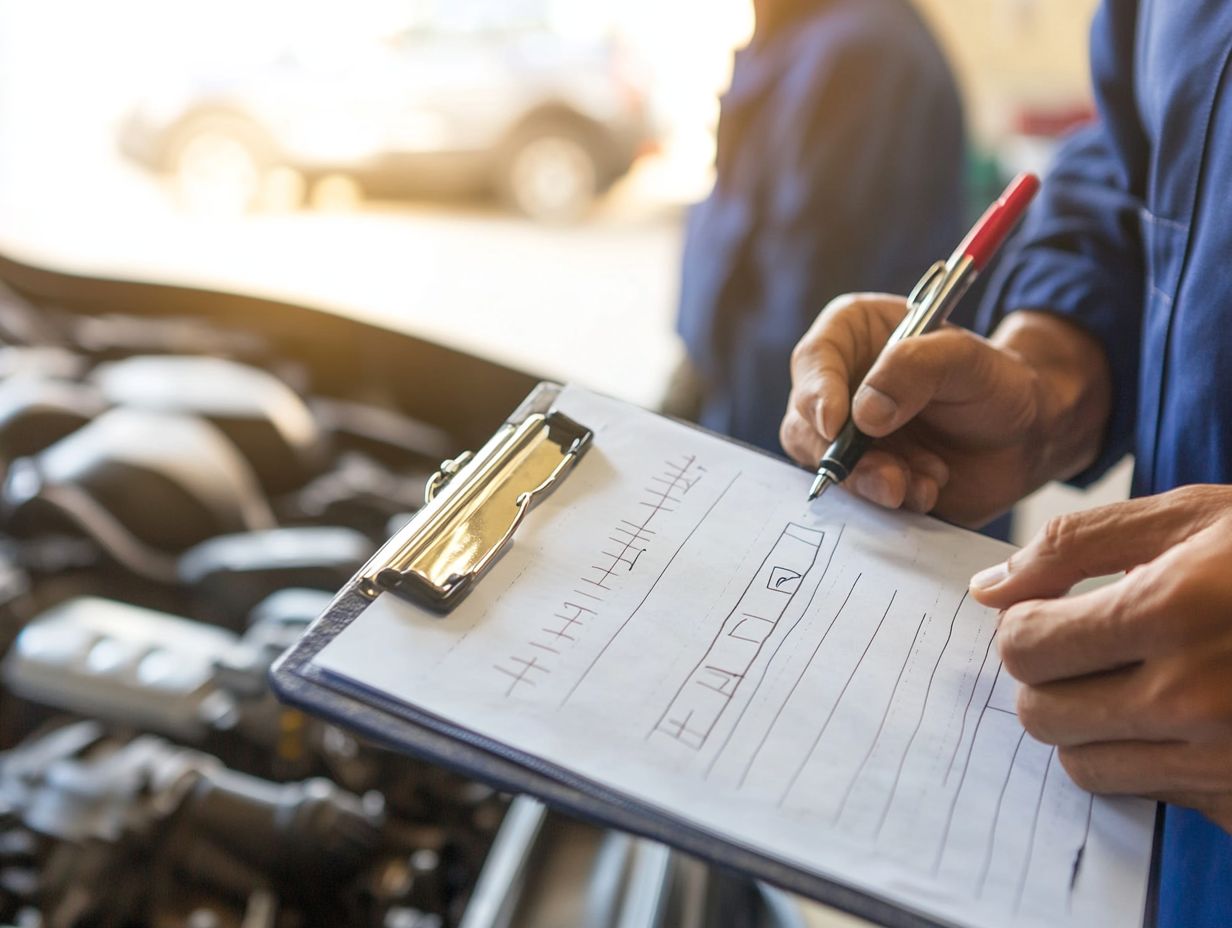
Ready to buy a used car? Check out this essential inspection checklist!
An essential car inspection checklist before buying a used car is a list of important factors and components to check. To make the process easier, refer to this guide on how to inspect a used car before purchase, which helps ensure the vehicle is in good condition and avoids any potential issues or surprises.
Why is it important to have an essential car inspection checklist before buying a used car?
Having an essential car inspection checklist is crucial as it helps you make an informed decision about the purchase. It can also help you identify any potential problems with the vehicle and save you from future expenses and headaches.
What are the key components that should be included in an essential car inspection checklist?
- Exterior and interior condition
- Engine
- Transmission
- Tires
- Brakes
- Suspension
- Overall functionality of the vehicle
Can I do the car inspection myself or should I hire a professional?
It is recommended to hire a professional mechanic to conduct the car inspection. They have the knowledge and experience to thoroughly check the vehicle, providing a detailed report and recommendations for any repairs or maintenance needed.
Before you make a purchase, consider conducting your inspection or consulting with an expert to ensure you’re making a wise investment!
What if the used car I want to buy does not pass the essential car inspection checklist?
If the used car doesn t pass the inspection, think twice about buying it.
Talk to the seller about fixing the issues, or look for another vehicle that meets your needs.
Is it possible to find a used car that passes the essential car inspection checklist with flying colors?
Absolutely! You can definitely find a used car that passes the inspection with flying colors.
Just remember, no car is perfect, and there might be small issues that are easy to fix.
As long as the overall condition is good and it fits your needs, it s a great choice.

